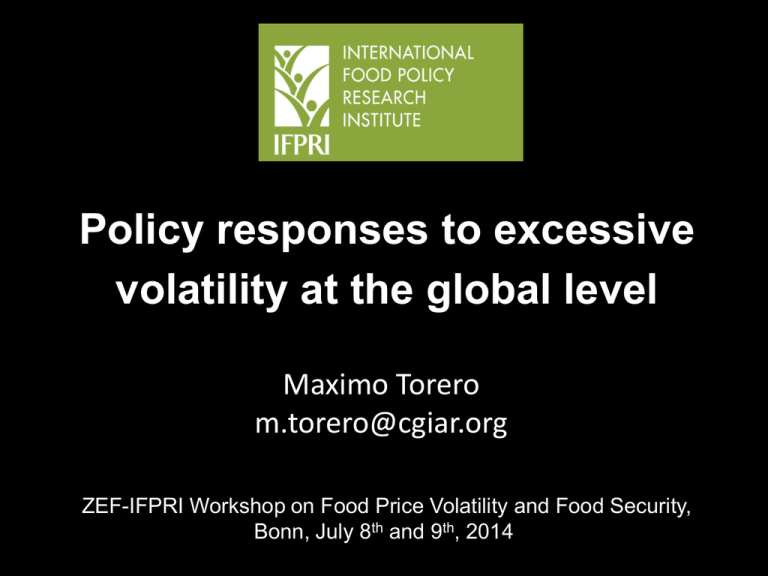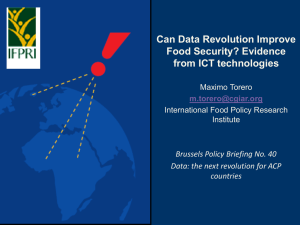Policy responses to excessive volatility at the global level Maximo Torero
advertisement

Policy responses to excessive volatility at the global level Maximo Torero m.torero@cgiar.org MTT ZEF-IFPRI Workshop on Food Price Volatility and Food Security, Bonn, July 8th and 9th, 2014 What we learned from 2007-08? Evolution of prices 6,000 800 Butter US$/metric ton 600 Wheat Rice 400 200 0 Indicative export prices, f.o.b Maize 5,000 Milk 4,000 3,000 2,000 1,000 0 Source: FAO (Food and Agriculture Organization of the United Nations). 2011. International commodity prices database. Available at www.fao.org/es/esc/prices/PricesServlet.jsp?lang=en. Maize = US No.2, Yellow, U.S. Gulf; Wheat = US No.2, Hard Red Winter ord. prot, US f.o.b. Gulf; Rice = White Broken, Thai A1 Super, f.o.b Bangkok; Butter = Oceania, indicative export prices, f.o.b.; and Milk = Whole Milk Powder, Oceania, indicative export prices, f.o.b. What was the response • Export bans and restrictions • Policies to stabilize prices • New initiatives on reserves • Food subsidies • Price controls on strategic staples or on trader margins • Input subsidies Effects on world prices of trade policy reactions for selected countries Policy Effects Exogenous demand increase [initial perturbation] Effects of increases in export taxes to mitigate the shock on domestic prices “Natural” Shock Effects of decrease in import duties to mitigate the shock on domestic prices Interaction effects between import and export restrictions 0% 10% 20% Source: Bouet and Laborde, 2009. MIRAGE simulations What was the proposed options in 2008-09 (1) ER = Emergency Reserve, Von Braun & Torero (2009 a,b) (2) ICGR= Internationally coordinated grain reserves, Linn (2008) (3) RR = Regional Reserves as the one of ASEAN (4) CR = Country level reserves, this could imply significant relative costs at the country level, significant distortions and little effect on volatility given low effect over international markets. (5) VR= Virtual Reserves, Von Braun & Torero (2009) (6) DFIF=Diversion from industrial and animal feed uses, Wright 2009 (7) IS+IFA= Better information on Storage and International Food Agency (Wright 2009) (8) IGCA= International Grain Clearance Arrangement, Sarris (2009) (9) FIFF= Food Import Financing Facility, Sarris (2009). (10) EWM=Early Warning mechanism (11) TF= Trade Facilitation - Wright (2009) and Lin (2008) How are we today? Price Levels Price Levels Periods of Excessive Volatility 2014 Please note Days of Excessive volatility for 2014 are through March 2014 Note: This figure shows the results of a model of the dynamic evolution of daily returns based on historical data going back to 1954 (known as the Nonparametric Extreme Quantile (NEXQ) Model). This model is then combined with extreme value theory to estimate higher-order quantiles of the return series, allowing for classification of any particular realized return (that is, effective return in the futures market) as extremely high or not. A period of time characterized by extreme price variation (volatility) is a period of time in which we observe a large number of extreme positive returns. An extreme positive return is defined to be a return that exceeds a certain pre-established threshold. This threshold is taken to be a high order (95%) conditional quantile, (i.e. a value of return that is exceeded with low probability: 5 %). One or two such returns do not necessarily indicate a period of excessive volatility. Periods of excessive volatility are identified based a statistical test applied to the number of times the extreme value occurs in a window of consecutive 60 days. Source: Martins-Filho, Torero, and Yao 2010. See details at http://www.foodsecurityportal.org/soft-wheat-price-volatility-alert-mechanism . In summary Crop Conditions in AMIS countries (as of May 28th) 18 Have there been an improvement in the short term? Global Stock to use ratios High concentration of exports: Top 5 Exporters Some improvements % of Exports from the Northern Hemisphere Source: USDA Some Improvements Significant increase on the production of wheat by the Black Sea region Source: USDA Proportion of maize production of the US in the production of biofuels, 1995–2010 Maize million of metric tons Source: USADA % of maize used in ethanol Projection of the US ethanol production Bill Litros Source: EIA, AEO 2013 Number of extreme events Increase in the number of extreme events Source: www.emdat.be Year International markets are vulnerable to climatic shocks Wheat Index of export volume (1990/91=100) 500 450 400 350 300 250 200 150 100 50 0 Black Sea region OECD exporters Latin America NOT ENOUGH Effects of excessive volatility • Price excessive volatility also has significant effects on producers and consumers • First, excessive price volatility is associated with greater potential losses for producers. Because high volatility implies large, rapid changes in the prices, making it more difficult for producer to make optimal decisions on the allocation of inputs • Second, many rural households not only consume, but they are also producers of agricultural commodities. This will directly affect their household income (if net sellers, or their level of self-consumption) and their consumption decisions • Finally, excessive price volatility over time can also generate larger returns. Increased price volatility may thus lead to increased—potentially speculative—trading that exacerbates price swings A simple model for producers' profit maximization Source: Martins-Filho, & Torero ,( 2010) A simple model for producers' profit maximization Source: Martins-Filho, & Torero ,( 2010) A simple model for producers' profit maximization Source: Martins-Filho, & Torero ,( 2010) Measuring effects over relative prices Source: Martins-Filho, & Torero, ( 2013) How vulnerable are we in the medium and long term? Growth of Global Demand Growing Human Pressure Restrictions in the access to Land Percapita arable land (per capita hectare used) Source: Bruinsma 2009 Expansion of the land with low level of nutrient reserves (K) Source Ahamed et al 2006 Climate change Ecosystem decline Climate Change Increase in the number of extreme events Important consequences on climate and for appropriate climate for crops Surprise Number of extreme events The concentration of greenhouse gases is increasing Source: Andy Jarvis, Carolina Navarrete, Julian Ramirez, Emmanuel Zapata, Peter Laderach; Centro Internacional de Agricultura Tropical, CIAT. Cali 2012 Source: www.emdat.be Year What is the global governance response? G20 Food Security Initiatives Initiative Agricultural Market Information System (AMIS) and Rapid Response Forum Start Goal 2011 Transparency in markets and encourage coordination in policy response Global Agricultural Geo-monitoring Initiative (GEOGLAM) 2011 Forecast agricultural production Code of Conduct for Emergency Humanitarian Food Reserves 2012 Humanitarian reserves instead of trying to affect prices in the market ECOWAS Emergency Humanitarian Food Reserves 2011 Regional strategic emergency Humanitarian reserves Removal of Export Restrictions on Food Purchases for Non-commercial Humanitarian Purposes by the World Food Program (WFP) 2011 Still discussion continue with WTO AgResults 2012 Pulling mechanism. Pilot project focuses on maize production in Sub Saharan Africa (farm storage technology; reduction of alfatoxin contamination) G20 Food Security Initiatives Initiative Tropical Agricultural Platform Start Goal 2012 Tropical agricultural innovation to improve production and productivity. Meeting of Chief Agricultural Scientists (MACS) 2012 Promote collaboration between public and private sector organizations International Research Initiative for Wheat Improvement (IRIWI) 2012 Reinforce cooperation and coordination between national and international bread and durum wheat research programs Platform for Agricultural Risk Management (PARM) 2013 Provide expertise and solutions for risk management and facilitating co-ordination among practitioners in this field Improving Efficiency of Water Use 2013 Science based and policy based options to improve the efficiency of water use in agriculture G20 Food Security Initiatives Initiative Start Goal Identify Best Practices to Increase Agricultural Productivity Growth Sustainably 2012 Consistent framework for on-going analysis of current national approaches and policy practices to increase sustainable agricultural productivity growth Multilateral Development Bank Action Plan for agriculture, food security and nutrition 2011 Report still not delivered Support the Agreement to scale up nutrition 2011 Significant progress with SUN Support the Principles for Responsible Agricultural Investment 2011 Field testing G20 Australia G20 Australia Source: MIRAGRODEP model simulations, IFPRI 2014 G20 Australia • Economic growth will lead to improvement in food security • More than 2 per cent above the trajectory implied by current policies over the coming 5 year A 10% increase in GDP/PC leads to a 6% reduction in stunting Source: Ruel and Alderman, 2013 Income Growth Can Have Unintended Consequences of Increasing Risks of Overweight and Obesity A 10% increase in GDP/PC leads to a 7% increase in overweight and obesity in women Ruel and Alderman, 2013 43 Where should we go? What to do? • In the short and medium term: Market-Based Hedging Strategies for coping with excessive volatility • In the short term – Targeted cash transfers (conditional or unconditional) for the most vulnerable groups • In the medium and long term: Measures to increase productivity, sustainability and resilience of agriculture Market-Based Hedging Strategies • In countries with well-integrated commodity exchanges: mechanisms of financial hedges and physical commodity hedges, which integrate price protection into a physical import or export agreement, may be more feasible • In countries that don’t have this: it is important first to build the necessary institutional arrangements to advocate for financial risk management instruments • Use of weather or catastrophe risk transfer instruments should be specially considered Medium and long term policies • Pro-trade policies: • Improve Availability of food products (quantity). Trade • • • • allows to rely on world supply (large and stable) At a low price. By definition, for importing countries : world price < domestic price, and in “real” terms: increasing income of households trade liberalization Of improved quality. But trade openness generates winners and losers. It can increase inequalities! • Role for redistributive policies and safety nets And some conflicting issues. FDI in land vs “land grabbing”: redefining property rights may lead to improved environmental sustainability but may lead also to social conflicts Source: Deason and Laborde (2010) United Kingdom Ukraine Turkmenistan Tunisia Thailand Switzerland Solomon Isds Seychelles Serbia and Montenegro Saint Kitts and Nevis Romania Rep. of Korea Portugal Pakistan Average Tariff on Calories Norway Nigeria Morocco Malta Kenya Japan Israel Ireland India Iceland Equatorial Guinea 80.00% Cyprus Congo Chad Central African Rep. Bermuda Import tariffs on food products: a heavy burden for the poor Average Tariff on Proteins 70.00% 60.00% 50.00% 40.00% 30.00% 20.00% 10.00% 0.00% Medium and long term policies • Policies to increase agricultural productivity and resilience • Input subsidies – Transitory, smart and well targeted input subsidies • Increase competition in the input industry • Investment in R&D • Investment in infrastructure – irrigation and roads • Policies to reduce post-harvest losses – Improved handling of harvests and storage practices – Information systems – Rural roads Thanks!




![[These nine clues] are noteworthy not so much because they foretell](http://s3.studylib.net/store/data/007474937_1-e53aa8c533cc905a5dc2eeb5aef2d7bb-300x300.png)

